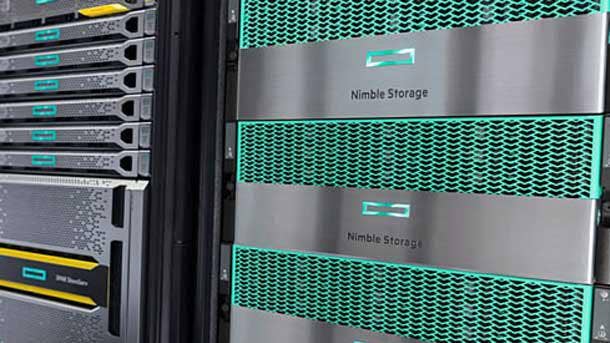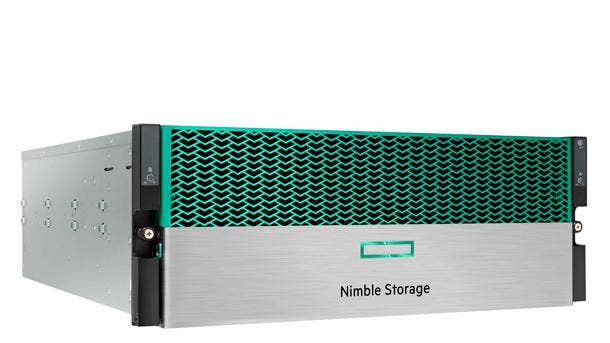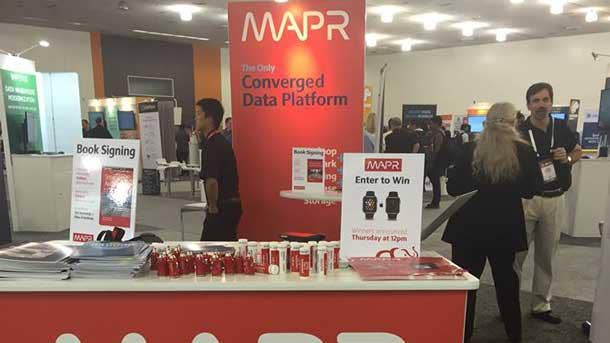HPE Plans To Use InfoSight, Channel To Continue Market Share Attack On Dell EMC, NetApp
HPE had the storage industry's highest growth rate in the second quarter, helping it leap over NetApp to the number two spot even as it hones its InfoSight predictive analytics and its new Primera line to take on Dell EMC, said HPE storage head Milan Shetti.

Enjoying The Growth
The second quarter of 2019 was marked by contraction of the storage array industry as a whole, but it also saw HPE ride the fastest-growing revenue of the top vendors to leap over NetApp to become the number-two vendor after arch-rival Dell EMC.
HPE's second quarter 2019 storage array revenue grew 13.5 percent over the same period of 2018 to $740.4 million, according to analyst firm IDC, led by what HPE itself reported was a 21-percent rise in sales of its Nimble Storage line. That growth was a big deal given the industry as a whole fell 0.8 percent to $6.3 billion.
Milan Shetti, senior vice president and general manager of HPE’s Storage Business Unit, told CRN that his company's growth was a combination of a strong indirect channel and the acceptance by the market of HPE's Intelligent Data Platform, which uses artificial intelligence to reduce storage costs and improve management. The Intelligent Data Platform, along with a major indirect channel presence and the newly-released Primera storage array with full AI and predictive analytics capabilities are expected to be the key tools HPE uses to continue that growth, Shetti said.
Shetti recently sat down with CRN to discuss HPE's storage growth, its expectations of the future, and its ability to compete with the likes of Dell EMC, NetApp, and Pure Storage. For insight into its plans, turn the page.

How did HPE storage do so well in the second quarter?
There were three reasons. First and foremost, I would like to thank the channel for the adoption of our products and the channel motion for all of HPE storage products in the second calendar quarter, as reported by IDC. And also, HPE's first fiscal quarter was fantastic. A big, big thank you goes to the channel. That was by far the biggest driver for the phenomenal growth that we posted, and also a significant market share gain. … Typically, about 80 percent goes through indirect channels.
What else drove that growth?
The message centered on our Intelligent Data Platform message is resonating really well with the channel. Especially things such as InfoSight, which is our predictive analytics engine. We have a channel and a partner portal as well so the channel and our partners have their own multi-tenant view into their installed base and how their installed base is doing. That has been a significantly important driver for us. That customer intimacy which InfoSight provides for our channel partners to their end customers was, I believe, one of the biggest drivers.
And the third driver?
The line-up of the product and the product portfolio that we have. HPE 3PAR storage did really well in the channel. So did Nimble. ... And SimpliVity also did real well in the market. But overall, I was really pleased about the entire portfolio kicking in, and the channel's adoption of InfoSight being one of the key levers of the driver of the Intelligent Data Platform and the intelligence era story which we have been working with the channel on.

How did HPE's sales of its Nimble storage line change year-over-year?
In the second quarter of the fiscal year for HPE, which is one quarter off of the calendar quarter, Nimble storage was up year-over-year by 45 percent. And in the third fiscal quarter [which ended July 31], it was up 21 percent year-over-year. ... 100 percent of the Nimble products go through the channel.
How about 3PAR storage?
3PAR also posted double-digit growth in those quarters. 3PAR also goes channel as well as direct. Some larger enterprises do go direct. But about 80 percent of 3PAR sales do go through the channel.
What about the new Primera line, announced in June?
I'm very bullish about Primera's growth through the channel as well, and very bullish about the upcoming quarters' year-over-year growth we are going to be posting as well, because now we'll have 3PAR, Primera, and Nimble. And we actually expect more and more of the Primera brand will also see adoption by the channel.

Will Primera cannibalize sales of 3PAR or Nimble Storage?
Neither. I am very bullish about the overall block storage market share [Primera is] going to have. We started taking orders for Primera in August. We gave the initial customers about six weeks shipment lead time just to get the demand [ready]. Of all the orders placed … almost all of them are wins against EMC. And almost all the deals which we have right now, which we're starting [to ship now], are channel-driven. So we are going back to the intelligence message, InfoSight, Primera, the ease of use of Primera, as well as the 100-percent availability guarantee, this has resonated so well. ... 100 percent of the Primera orders so far which we have booked are channel-driven. And they are almost all EMC take-outs.
Why would they be an EMC take-out?
What we have learned from [the market] is that EMC hasn't got a very engaging portfolio when it comes to block storage. It's not efficient. There is also no intelligence message [that resonates as well as our] InfoSight and our predictive intelligence message. ... And also the visibility we provide through InfoSight for the channel partners, they feel so comfortable with it. So that's been a big driver.
That is something that we were theorizing could happen in the large accounts and large deals which we take direct … . [But] the channel adoption of the message of InfoSight as well as the aging portfolio of Dell EMC--[there's] a huge installed base which needs to be refreshed and modernized--nothing comes close to what we provide with InfoSight. This is the primary driver of why we are winning against Dell EMC.

But Dell EMC is also preparing to refresh its product lines. Why wouldn't customers look at the Dell EMC refresh at the same time they look at Primera?
Yes, there's a [Dell EMC] product refresh coming. But I don't think the intelligence, the predictive analytics, the machine learning are there. I can only speculate until it comes out. We present to the channel much as EMC does. And the channel always gets an opportunity to choose. The fact that they're choosing to refresh with Primera on the EMC installed base, this is a market opportunity for us. And the fact that people are saying InfoSight is the reason, it tells me that what we have with predictive analytics and the power of insights about the data we give to the channel partners, they must not be getting that from EMC because [the partners] always mention that as the differentiator.
Is Nimble Storage ever a part of a take-out of Dell EMC?
All day long. With Nimble, we've been averaging recently about 500 new logos a quarter. And that's all channel, given how Nimble works with the channel. And that's a massive number. Five hundred new logos a quarter and 100-percent channel worldwide is a pretty solid number. And given that Dell EMC as well as NetApp have the predominant installed bases out there, that just tells me Nimble is taking share. We see a lot of Dell EMC VNXs [and] Unity, and we see a lot of NetApp, which becomes a take-out for Nimble.

NetApp in the last quarter reported a big slowdown in storage even as HPE enjoyed a surge in storage sales. NetApp talked about the impact of macroeconomic conditions on the storage market. Did HPE see any impact from macroeconomic conditions?
We did not. ... The market is definitely uneven. But we don't see as big a slowdown as NetApp indicated. In fact, we're actually doubling down and growing both from the market share standpoint and our product portfolio standpoint. So we see the uneven market, but we don't see any impact from the dip which NetApp mentioned or from their outlook for the [following quarters].
So HPE had a great quarter. But markets change and market shares go up and down. What is HPE doing to help make sure it can continue to gain market share in a fast-changing business?
Number one is around the intelligence era message and more products in the product portfolio to [spread that message]. And second is very channel-specific incentives as well as making sure the channel can see more and more intimacy with their customers by providing insights about their data. We will continue to offer these to stay ahead of the curve in terms of the market share.
And number three, we will go after the largest installed bases there are. The largest installed bases need to be refreshed, or they need to be completely transformed... . We're very selectively going after Dell EMC and NetApp. [We have] lots of competitive attack plans around that. Not just around refresh, which is incremental, but [we will] offer a magnitude of order better experience. That's what we're going to continue to do. We're going to absolutely stay on top of it to make sure that one quarter or two quarters is not a pattern.

Two of your competitors, NetApp and Pure Storage, have made the cloud a centerpiece of their storage offerings. What has HPE done in terms of connecting its storage to the cloud?
We have two sets of cloud capabilities. One is around Cloud Volumes, let's call it primary storage in the cloud. And the second one is secondary storage, CloudBank. CloudBank is a capability neither Pure nor NetApp have. We have a very large installed base which is already cloud-connected on the secondary side, and also a pretty large installed base and a head start against Pure on the Cloud Volumes side. [In addition our] recent acquisitions of BlueData and MapR both have capabilities for Kubernetes and the hybrid cloud environment. That is not a capability that NetApp or Pure have.
Analysts have said, rightfully so, that more data is going to be created at the edge than in the core. I think the data fabric which connects the edge to the core or the edge to the cloud [comes together] with the Kubernetes and container ecosystem capabilities which BlueData provided. Between CloudBank for secondary [storage], Cloud Volumes for primary [storage], and now with the addition of MapR and BlueData in our product portfolio, we have the unique edge-to-core-to-cloud data fabric… . Neither NetApp nor Pure Storage have that.

HPE has 3PAR and Nimble Storage which are two different storage systems. Now you are starting to ship Primera. Will there be compatibility issues between HPE's storage platforms?
We have the ability to replicate data between Primera, 3PAR, and Nimble as part of a single federation. And they all sit behind InfoSight as the data browser. So we do have an ability for application-consistent and application-aware data mobility across the three platforms. I'll give you [an example]:
In InfoSight, we have something called a recommendation agent. ... We had a customer who had lots of SimpliVity devices, and a few of their virtual machines were really outgrowing the hyper-converged environment. Their compute needed to scale independent of storage. They had been adding more storage than the compute needs. So the InfoSight recommendation engine told the customer, 'You know what? These virtual machines are better off sitting on external storage rather than in a hyper-converged environment because their performance needs are dramatically increasing, and you need really, really fast flash array storage to do that. Do you want us to move the data for you?'
And in this case, the customer was not comfortable, but they did it initially [manually]. And then they got so comfortable that they just let InfoSight move the virtual machines from out of the hyper-converged infrastructure to the external storage.
What percent of HPE's storage revenue and capacity is all-flash storage?
About 70 percent is all-flash. The 30-percent which isn't all-flash are generally for workloads that need high-capacity drives for serving very, very large repositories. The majority of what we've done today is all-flash. ... And by the way, every single Primera that has been ordered is all-flash.
Is that 70 percent in terms of overall revenue or capacity?
That's in terms of capacity. Revenue-wise, the number might even be higher because of the cost differential.